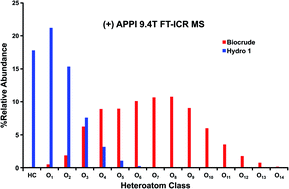Detailed chemical composition of an oak biocrude and its hydrotreated product determined by positive atmospheric pressure photoionization Fourier transform ion cyclotron resonance mass spectrometry
Abstract
The chemical composition of biomass-derived pyrolysis oils renders them undesirable for replacement of or blending with crude oils. The undesirable constituents result mainly from high oxygen content after pyrolysis, making oxygen the target for removal during subsequent upgrading. Catalytic hydrotreatment is the most common method for oxygen removal and can be performed during or after pyrolysis. The efficient removal of oxygen depends on its interaction with the catalyst, and therefore depends on the chemical composition of the oxygen-containing compounds. Knowledge of the oxygen composition before and after hydrotreatment provides insight into the removal process and possible applications for the upgraded oil. Here, we characterize an oak biocrude and its hydrotreated product by positive atmospheric pressure photoionization Fourier transform ion cyclotron resonance mass spectrometry to establish compositional changes that occur during hydrotreatment. A silica gel fractionation was also applied to enable separate analysis of the saturated and aromatic hydrocarbons from the hydrotreated pyrolysis oil.



 Please wait while we load your content...
Please wait while we load your content...